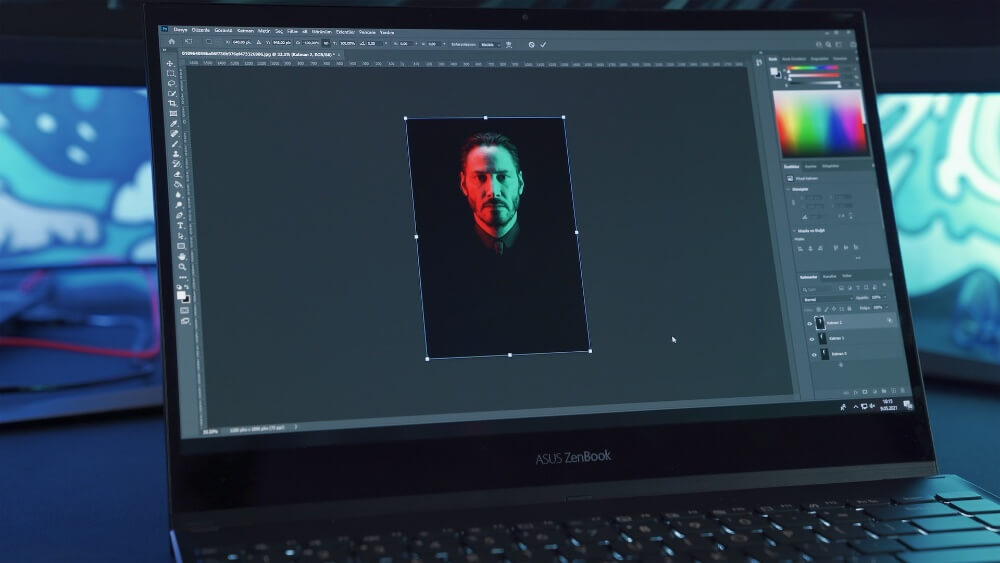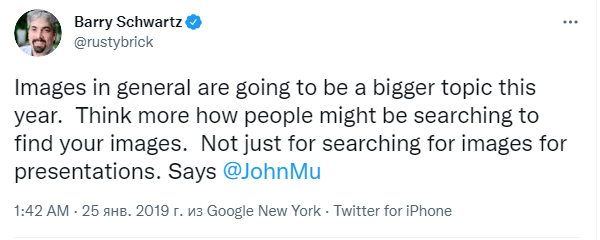
Photos and various image elements in general have long been an important part of search results. Google Images as a search engine was introduced in 2001 and has been widely used for searching ever since. A decade later its functionality was extended to reverse image searching.
Featured snippets used by Google for fast “answering” most frequently asked questions are normally displayed on top of the page with generated search results. Those featured snippets may contain image elements as well – getting them could definitely expand your website’s traffic and reach.
What Is Photo SEO For?
Search engine optimization of photos and other graphical content does two things:
Increases traffic because SEO friendly photos have more chances to get higher in Google search results, and
Gets ranks higher because web crawlers better understand content of optimized images, making less mistakes on relevance.

Source: Twitter
In the beginning of 2019 Barry Schwartz, CEO of RustyBrick and contributing editor to Search Engine Land, predicted that images would start playing a bigger role soon, so it’d be better to approach SEO image optimization more reasonably. It’s easy to guess that in 2021 the trend continues.
Today it’s hard to imagine a selling website without creative and quality content, but being eye-catching is nothing if it is not optimized properly to increase traffic. Working with images in photo editing programs, like photo retouching service, is now an important part of search engine optimization, and here are some basic strategies of how to perform SEO image optimization in 2021.
What Is SEO Image Optimization?
Some of the readers may still remember the “good old” times of dialup Internet in the 90’s when it could take virtually minutes for an image to load. Guess what – in times when time is money, and users are used to getting search results instantly, it isn’t much different. On the contrary - even a slight delay may cause them to “bounce”. Here are the best ways to prevent them doing that in 2021.
Choosing the Right SEO Image Size
According to one of 25 recent Google search statistics facts, compressing images significantly saves traffic volume and decreases bounce rates. Compression depends on the chosen image format. There are probably dozens of them, so we won’t examine all one after another, but a few most popular are:
GIF. Suits animated images best, also good for diagrams or logos. Yields fairly good compression results in case of simple images with few colors, but is less effective for photos. What’s good about it is its popularity with animation and wide software support it has achieved for all the years of its application.
BMP, or Windows image file format. The file format is apparently recognized in Windows quite easily, but images are heavy and uncompressed.
PNG. Originally created as a free alternative to GIF, this modern file format allows transparency for all palette colors, so it is definitely a better alternative when color transparency is needed. Although JPEG performs best with compression, PNG is widely chosen as a format to store images when working with them in photo editing programs although it is not the best choice for online distribution.
But JPEG probably is. The applied irreversible compression method achieves best results, so images stored in JPEG or JFIF are much lighter. Besides, any digital camera is able to store images in that format.
The right file format is only half of the story because images have to be published online in the original image resolution. If not, Internet browsers will have to do scaling of the image, thus negatively affecting website efficiency.
Free Online Alternatives
Getting SEO friendly images is much easier with SEO stocks with images. In many cases, they may even be free, allowing you to use the stock photo you like in the needed resolution (preferably small, if you aim for faster page loading times). Most likely, you’ll have to indicate the image source. Largest stocks with assorted hi-quality images normally require choosing a paid tariff plan to download and use their images. Using free reverse image search tools can help verify the uniqueness of your images, ensuring they are optimized for SEO and reducing the risk of duplicate content issues.
When it’s good for smaller companies, SEO image stocks may not be the best strategy in 2021 for a larger company which is working on its reputation and would rather demonstrate its uniqueness. If it has resources on that, it is better to upload unique images online because search engines are able to track images uniqueness as well, presumably giving them higher ranks.
The Text Aspect of SEO Image Optimization
Web crawlers are able to match graphical content with the subject of performed search, at the same time matching it all with the text around the image. This means that one also has to match one with the other.
Because of that, it is vital to choose sites for guest posting carefully. One and the same image illustrating the text on your website may cause different ranking results with the same text on an external resource.
All in all, SEO image optimization is obviously not a reason to forget about careful link building strategies, the aspect directly related to the previous point. Traffic sources should preferably be trusted, ranked higher, and bring more traffic, but adding images as another variable to that equation requires at least brief examination of the external website’s content before making a decision on an image to be added to the guest page.
Any image should come with a description to get search rankings higher. The main point is putting correct attributes to the HTML image tag <img src=“image.jpg” alt=“image description” title=“image tooltip”>. The “alt” and “title” attributes are immensely important, especially the first one as it provides description for the image and its functionality. If it is a button, for example, the description should say it is a button. As for the image tooltip which is put for title description, it is a commonly used user interface element to provide information on graphical elements whenever somebody hovers over them with a cursor.
By the way, naming images also has peculiarities. The best approach to naming image files is the same matching principle to ensure the name is aligned with the content. Not “IMG1464.jpeg”, for example, but more like “clouds-in-the-morning-sky.jpeg”
Photo Editing as a Vital Part of SEO
Keeping that in mind, one can’t imagine search engine optimization without photo editing programs precisely because it’s hard to think of a website consisting of text information without graphical illustrations. Because two content types are interrelated, both of the processes should go in connection.
One has to go deeper than optimizing image loading time by choosing the correct format and image resolution (thus improving users’ experience). It even goes further than manipulations with the alternative text and title attributes alone, although description of what’s on the image is very important for recognition by web crawlers. Image SEO is what is born “in the middle” as synergy.
Photo SEO is seen as important because not only it defines image ranking positions on SERPs: by doing so, it also increases your website’s optimization as a whole. Image search now accounts for one third of all queries in the US – says Moz. Image posts immediately catch attention and receive more reposts (human psychology, also supported by facts). Image optimization is thus vital for raising organic traffic and boosting sales.